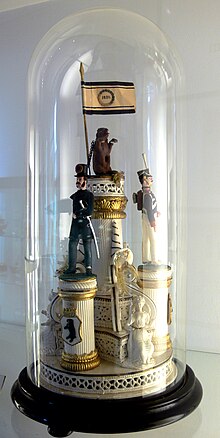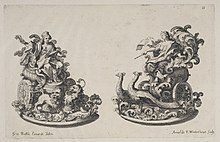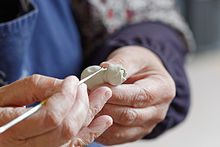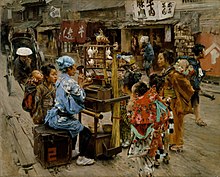
Confectionery is the art of making confections, which are food items that are rich in sugar and carbohydrates. Exact definitions are difficult. In general, however, confectionery is divided into two broad and somewhat overlapping categories: bakers' confections and sugar confections. The occupation of confectioner encompasses the categories of cooking performed by both the French patissier and the confiseur.

Cake is a flour confection made from flour, sugar, and other ingredients and is usually baked. In their oldest forms, cakes were modifications of bread, but cakes now cover a wide range of preparations that can be simple or elaborate and which share features with desserts such as pastries, meringues, custards, and pies.

A doughnut or donut is a type of pastry made from leavened fried dough. It is popular in many countries and is prepared in various forms as a sweet snack that can be homemade or purchased in bakeries, supermarkets, food stalls, and franchised specialty vendors. Doughnut is the traditional spelling, while donut is the simplified version; the terms are used interchangeably.

Marshmallow is a confectionery made from sugar, water and gelatin whipped to a solid-but-soft consistency. It is used as a filling in baking or molded into shapes and coated with corn starch. This sugar confection is inspired by a medicinal confection made from Althaea officinalis, the marsh-mallow plant.

Dough is a thick, malleable, sometimes elastic paste made from grains or from leguminous or chestnut crops. Dough is typically made by mixing flour with a small amount of water or other liquid and sometimes includes yeast or other leavening agents, as well as ingredients such as fats or flavorings.
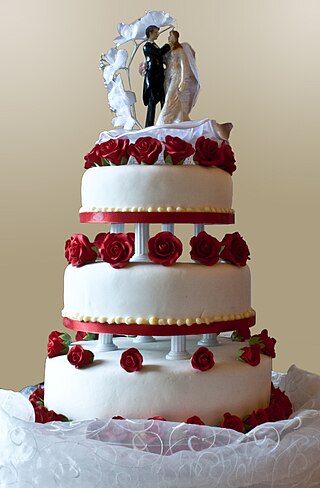
A wedding cake is the traditional cake served at wedding receptions following dinner. In some parts of England, the wedding cake is served at a wedding breakfast; the 'wedding breakfast' does not mean the meal will be held in the morning, but at a time following the ceremony on the same day. In modern Western culture, the cake is usually on display and served to guests at the reception. Traditionally, wedding cakes were made to bring good luck to all guests and the couple. Nowadays, however, they are more of a centerpiece to the wedding and are not always even served to the guests. Some cakes are built with only a single edible tier for the bride and groom to share, but this is rare since the cost difference between fake and real tiers is minimal.

Marzipan is a confection consisting primarily of sugar, honey, and almond meal, sometimes augmented with almond oil or extract.

Icing, or frosting, is a sweet, often creamy glaze made of sugar with a liquid, such as water or milk, that is often enriched with ingredients like butter, egg whites, cream cheese, or flavorings. It is used to coat or decorate baked goods, such as cakes. When it is used between layers of cake it is known as a filling.

A cupcake (AmE), fairy cake (BrE), or bun (IrE) is a small cake designed to serve one person, which may be baked in a small thin paper or aluminum cup. As with larger cakes, frosting and other cake decorations such as fruit and candy may be applied.

A mille-feuille, also known by the names Napoleon in North America, vanilla slice in the United Kingdom, and custard slice, is a French dessert made of puff pastry layered with pastry cream. Its modern form was influenced by improvements made by Marie-Antoine Carême.

Fondant icing, also commonly called simply fondant, is an icing used to decorate or sculpt cakes and pastries. It is made from sugar, water, gelatin, vegetable oil or shortening, and glycerol. It does not have the texture of most icings; rolled fondant is akin to modelling clay, while poured fondant is a thick liquid. The flavor is generally considered a weak point, as it is sweet and chalky. It is generally chosen for its appearance rather than the way it tastes.

Kue is an Indonesian bite-sized snack or dessert food. Kue is a fairly broad term in Indonesian to describe a wide variety of snacks including cakes, cookies, fritters, pies, scones, and patisserie. Kue are made from a variety of ingredients in various forms; some are steamed, fried or baked. They are popular snacks in Indonesia, which has the largest variety of kue. Because of the countries' historical colonial ties, Koeé (kue) is also popular in the Netherlands.
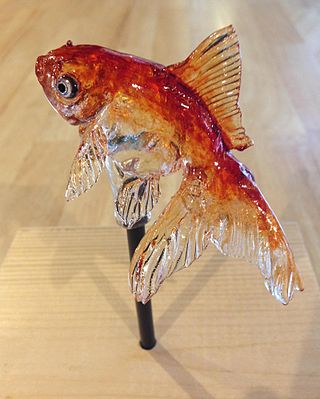
Amezaiku (飴細工) is Japanese candy craft artistry. An artist takes multi-colored mizuame and, using their hands and other tools such as tweezers and scissors, creates a sculpture. Amezaiku artists also paint their sculpted candy with edible dyes to give the finished work more character. Animals, including goldfish and insects, are common amezaiku shapes created to appeal to children. Intricate animal characters are created with expert speed. Some amezaiku artists are also street performers who perform magic tricks and tell stories along with their candy craft entertainment.

In cooking, a glaze is a glossy, translucent coating applied to the outer surface of a dish by dipping, dripping, or using a brush. Depending on its nature and intended effect, a glaze may be applied before or after cooking. It may be either sweet or savory ; typical glazes include brushed egg whites, some types of icing, and jam, and may or may not include butter, sugar, milk, oil, and fruit or fruit juice.

Dobos torte, also known as Dobosh, is a Hungarian sponge cake layered with chocolate buttercream and topped with caramel. The layered pastry is named after its inventor, Hungarian chef József C. Dobos, a delicatessen owner in Budapest. In the late 1800s, he decided to create a cake that would last longer than other pastries in an age when cooling techniques were limited. The round sides of the cake are coated with ground hazelnuts, chestnuts, walnuts, or almonds, and the hardened caramel top helps to prevent drying out, for a longer shelf life.

Cake decorating is the art of decorating a cake for special occasions such as birthdays, weddings, baby showers, national or religious holidays, or as a promotional item.

Cookie decorating dates back to at least the 14th century when in Switzerland, springerle cookie molds were carved from wood and used to impress Biblical designs into cookies.

Candy making or candymaking is the preparation and cookery of candies and sugar confections. Candy making includes the preparation of many various candies, such as hard candies, jelly beans, gumdrops, taffy, liquorice, cotton candy, chocolates and chocolate truffles, dragées, fudge, caramel candy, and toffee.
Fondant is a mixture of sugar and water used as a confection, filling, or icing. Sometimes gelatin and glycerine are used as softeners or stabilizers.

